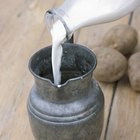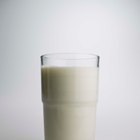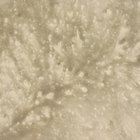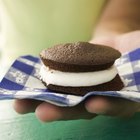
Alexandra Grablewski/Digital Vision/Getty Images
Rennet refers to a milk-fed calf's fourth stomach and the complex of enzymes that occur naturally in it. Rennin, one such enzyme, is an emulsifier and thickener and it causes milk proteins, such as casein, to coagulate. In calves, rennin assists with digesting the mother's milk. When added to ice cream, rennin improves texture and consistency, preventing lumpy ice crystals from forming.
Rennet and Ice Cream
Cream is a natural emulsion of fat and casein protein, suspended in water. Rennet causes caseins to stick together, forming three-dimensional structures. As these structures form, they trap fat globules within them. To the naked eye, rennet-treated cream looks like a custard. Rennet-treated cream eliminates the need for making an egg custard, a precarious task involving mixing hot cream into room-temperature eggs, or tempering the eggs as for a cream and egg custard-based ice cream.
The Goldilocks Zone
Renneted milk proteins tend to coagulate at roughly 86 to 88 degrees Fahrenheit, and rennet thrives in temperatures of 85 to 105 F. Ice cream recipes involving rennet require you to heat the sweetened, flavored cream to approximately 110 F, add the rennet and let the renneted lukewarm cream sit undisturbed for about 10 minutes before chilling it. While the cream sits, rennet reacts with milk proteins and subsequent chilling encourages the proteins to coagulate. Failure to follow these steps precisely can sabotage coagulation, preventing the renneted cream from setting correctly.
What Rennet Does to Milk Proteins
All milk contains natural anti-clumping agents that prevent casein from clinging together into structures. These anti-clumping agents, called glucomacropeptides, stick to the exterior of casein particles, or casein micelles. Glucomacropeptides are water soluble, and their presence on the surface of casein micelles allows the casein to flow freely through the milk. Rennet removes the anti-clumping agent from casein micelles. Because casein is naturally resistant to water, it begins coagulating at once.
Makine Ice Cream Without Rennet
Rennet isn't an essential ingredient to ice cream, only a helpful ingredient. Using rennet is like taking a shortcut to preparing custard. While making custard is one way to make ice cream, it's not the only way. Ice cream is a chilled emulsion, and you can attain this same result by agitating heavy cream over a source of cold.
Related Articles

Why Does Milk Curdle When Baking a ...

Why Does Cream Turn Into Butter?
The Difference Between ...
Cream vs. Creamer

How Many Calories Are in Cream of Wheat?

How to Keep Scalloped Potatoes From ...

How to Cook With Lactaid

How to Fix Runny Boston Cream Filling
What Do Bakeries Use in Their Whipped ...

How to Keep Custard Sauce From Curdling

Uses for Curdled Milk

Why Can't You Use Ultra Pasteurized ...

Differences Between Double Cream and ...

Why Does Some Alcohol Curdle Cream?

How to Make Whipped Frosting Without ...

How to Harden Up Whipped Cream

Does Lime Make Sour Cream Curdle?

How to Substitute Cream for Buttermilk

How to Use Evaporated Milk for Drinking

What Is the Meaning of Judgmental?
References
Writer Bio
Born in New York City, Tremaine Jackson has been in theater, dance and music since age 12, when he appeared in Liz Swados' "Swing" at the Brooklyn Academy of Music. He is also an award winning children's recording artist. He writes fiction and poetry in his spare time.
Photo Credits
Alexandra Grablewski/Digital Vision/Getty Images